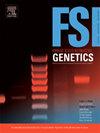丹麦人眼睛和头发颜色的基因预测
IF 3.1
2区 医学
Q2 GENETICS & HEREDITY
引用次数: 0
摘要
眼睛和头发颜色的基因预测是法医DNA表型分析可以帮助解决刑事案件的突出例子。法医遗传学中高通量基因分型技术的出现开辟了在法医环境中应用多基因风险评分的可能性。在这项工作中,我们比较了HIrisPlex和PRSice-2在预测眼睛和头发颜色方面的性能,以深入了解新方法的相对优势。研究人员对584名丹麦高中生进行了预测,这些学生的遗传和自我报告的表型数据都是可用的。棕色眼睛颜色的预测非常准确(AUC = 0.98),其次是蓝色眼睛颜色(AUC = 0.82),而中间眼睛颜色的预测失败(AUC = 0.57)。至于发色,红色和黑色总体上比金色和棕色更好预测,PRSice-2在除黑色发色外的所有发色上都表现更好。尽管该研究存在局限性,但HIrisPlex在预测棕色和蓝色眼睛颜色以及红色和黑色头发颜色方面表现出了通常的高性能。然而,与HIrisPlex相比,PRSice-2在头发颜色预测方面提供了全面的改进,这表明通过使用多基因风险评分在法医DNA表型分析方面还有改进的空间。本文章由计算机程序翻译,如有差异,请以英文原文为准。
Genetic predictions of eye and hair colour in the Danish population
Genetic predictions of eye and hair colour are prominent examples of forensic DNA phenotyping that can help resolve criminal cases. The advent of high-throughput genotyping technologies in forensic genetics opens up the possibility of applying polygenic risk scores in forensic settings. In this work, we compare the performance of HIrisPlex with PRSice-2 in predicting eye and hair colour to gain insights into the relative benefits of new approaches. Predictions were carried out on 584 Danish high school students for which genetic and self-reported phenotype data were available. Prediction of brown eye colour was very accurate (AUC = 0.98), followed by blue eye colour (AUC = 0.82), while it failed for intermediate eye colour (AUC = 0.57). As for hair colour, red and black were overall better predicted than blond and brown, and PRSice-2 performed better in all but the black hair colour. Despite the limitations of the study, HIrisPlex exhibited its usual high performance in the prediction of brown and blue eye colour, as well as red and black hair colour. However, PRSice-2 offered overall improvements in hair colour prediction over HIrisPlex suggesting that there is room for improvement in forensic DNA phenotyping by using polygenic risk scores.
求助全文
通过发布文献求助,成功后即可免费获取论文全文。
去求助
来源期刊
CiteScore
7.50
自引率
32.30%
发文量
132
审稿时长
11.3 weeks
期刊介绍:
Forensic Science International: Genetics is the premier journal in the field of Forensic Genetics. This branch of Forensic Science can be defined as the application of genetics to human and non-human material (in the sense of a science with the purpose of studying inherited characteristics for the analysis of inter- and intra-specific variations in populations) for the resolution of legal conflicts.
The scope of the journal includes:
Forensic applications of human polymorphism.
Testing of paternity and other family relationships, immigration cases, typing of biological stains and tissues from criminal casework, identification of human remains by DNA testing methodologies.
Description of human polymorphisms of forensic interest, with special interest in DNA polymorphisms.
Autosomal DNA polymorphisms, mini- and microsatellites (or short tandem repeats, STRs), single nucleotide polymorphisms (SNPs), X and Y chromosome polymorphisms, mtDNA polymorphisms, and any other type of DNA variation with potential forensic applications.
Non-human DNA polymorphisms for crime scene investigation.
Population genetics of human polymorphisms of forensic interest.
Population data, especially from DNA polymorphisms of interest for the solution of forensic problems.
DNA typing methodologies and strategies.
Biostatistical methods in forensic genetics.
Evaluation of DNA evidence in forensic problems (such as paternity or immigration cases, criminal casework, identification), classical and new statistical approaches.
Standards in forensic genetics.
Recommendations of regulatory bodies concerning methods, markers, interpretation or strategies or proposals for procedural or technical standards.
Quality control.
Quality control and quality assurance strategies, proficiency testing for DNA typing methodologies.
Criminal DNA databases.
Technical, legal and statistical issues.
General ethical and legal issues related to forensic genetics.

 求助内容:
求助内容: 应助结果提醒方式:
应助结果提醒方式:


